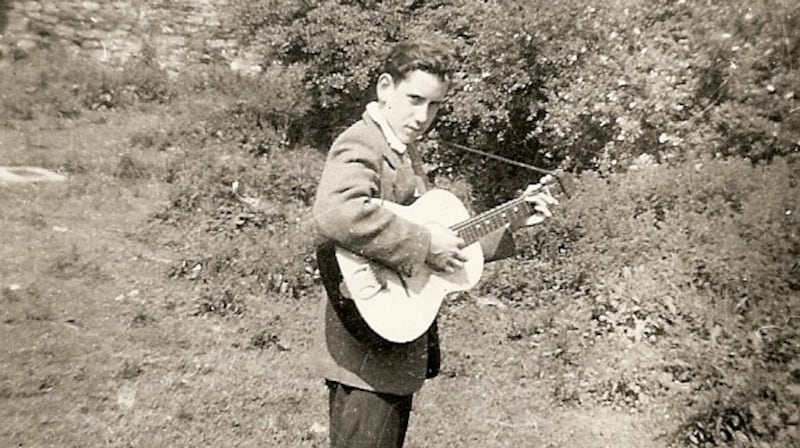Though it was recorded relatively early in what would be a long and illustrious career, it’s hard to think of a more appropriate title for Louis Stewart’s great solo masterpiece, which is re-released this week on the reborn Livia label. Almost from the very beginning of his life as a musician, Louis – to use the mononym by which his fans and fellow musicians knew him – really was out on his own, still perhaps the only Irish jazz musician to attain front rank status internationally. That this feat was achieved from a Dublin base, by an artist who was unusually self-effacing and shy, makes the achievement all the more remarkable. His fame was always greater abroad, and though he had a small but fiercely loyal following in his hometown, it was only towards the end of his life that the honours came and we in Ireland began to realise that here in our midst – still performing weekly gigs in small upstairs rooms around the city until his death in 2016 – was one of the great geniuses of modern music, an Irish artist to stand alongside Heaney and Beckett as one who transcended his art form and earned the respect and admiration of his peers around the world.
[ In the court of King Louis: An Irishman’s Diary about Louis Stewart at 70Opens in new window ]
Being a Dubliner was important to Louis Stewart. Though profiles often cite his birth in Waterford in January 1944, his parents moved back to Dublin while he was still a baby, and he grew up in the Liberties in the heart of Dublin’s south inner city. And never was there more of a Dub, in his accent and his manners, in his dark, laconic wit and in his fierce affection for his hometown. When he was 14 his mother, Mary, bought him his first guitar and he was still only 16 when he presented himself at an audition for the Chris Lamb showband at the old Four Provinces Hotel on Harcourt Street. The audition was conducted by the band’s pianist, Jim Doherty, who was to become one of Stewart’s closest friends and musical collaborators. Doherty remembers enduring a succession of unlikely lads aping Buddy Holly and Elvis Presley, until a shy, scrawny kid walked nervously into the room, guitar in hand, and asked “Eh, do you know any Benny Goodman tunes?”
Doherty and Stewart jammed for 10 minutes on Goodman’s Seven Come Eleven, and the unlikely lads were told that the position had been filled. “I knew within four bars,” remembers Doherty, “that this kid was special.” Indeed he was. Less than 10 years later, the scrawny kid would be touring internationally as a member of Goodman’s band.
All that lay ahead, as young Stewart embarked on his first professional engagement. It was a time when musicians in Catholic Ireland could not work at home during Lent, and there was a well-beaten path to the Irish-American circuit in the US to fill the hungry gap. Stewart knew this, and it is certain that the opportunity to travel to New York and hear jazz played in its heartland was at least part of the motivation for joining Chris Lamb’s band. Years later, in an interview with broadcaster John Kelly for The Irish Times, he recalled his first time in New York. “The band I was with only played at the weekends in an Irish ballroom, so all the nights during the week I was down in Birdland listening to [saxophonist] Stan Getz. It was unbelievable. They had a section for minors so I’d order a Coke with loads of ice to make it last. I just sat there listening to Stan Getz for two weeks.”
RM Block
Stewart returned to Dublin with his mind made up. “Being in the showband, I really thought I was getting into being a professional musician,” he told Kelly. “But in fact I was getting further and further away from music. So I quit and I spent about six months doing hardly any gigs at all – just started trying to figure out the guitar.” It was arguably the first time that an Irish musician had decided to devote themselves exclusively to the precarious life of a jazz artist.
[ Louis Stewart: First he takes Manhattan ...Opens in new window ]
Dublin in the early 1960s was not exactly the ideal place from whence to launch such a career, but Stewart quickly attracted the admiration of his fellow musicians. His first regular jazz gigs came in 1965 at the Martello Room, a glamorous restaurant on the roof of the Intercontinental Hotel (later Jurys) in Ballsbridge. Also important to his rapid ascent was the legendary Fox Inn. It was at this most unlikely of jazz clubs in Ashbourne, Co Meaht, 15 miles out of Dublin, that Louis really honed his craft, playing sometimes five nights a week with his own trio, as well as accompanying visiting American stars, including a weeklong engagement with the great US saxophonist Lee Konitz.
In 1968 Stewart was part of a group led by Doherty that represented Ireland at the Montreux Jazz Festival, and the young guitarist caused a sensation, winning an award from the international press jury for Outstanding European Soloist. The following year, Louis returned to Montreux and this time won the Grand Prix de la Radio Suisse Romande for the best soloist at the festival, a prize that included a scholarship to the prestigious Berklee College of Music in Boston. Stewart had announced himself on the international stage, and word of this brilliant young Irish guitarist, already entirely fluent in the post-bop language of jazz, began to spread.

He would never take up the offer to study at Berklee. “Jazz,” he said, “can be learnt, but not taught.” Instead, he joined the band of renowned English saxophonist Tubby Hayes, and was soon dividing his time between Dublin and London, where he later became a member of saxophonist Ronnie Scott’s quintet. As a member of the house band at the saxophonist’s eponymous club, Stewart played with many of the eminent American artists who visited London in the 1970s. It was there that he caught the ear of Goodman and was invited to join the legendary clarinettist for a series of European tours.
Louis’s visits home to his beloved Dublin during this period were important milestones in the development of the Irish jazz scene. His legendary concerts at the Baggot Inn during the mid-1970s attracted large and enthusiastic audiences, and would inspire the next generation of Irish jazz musicians. To hear an Irish musician playing at such a high level – one who was revered abroad and was touring with jazz greats such as Goodman and pianist George Shearing – was transformative, evidence that Irish musicians could aspire to a jazz career at the highest level.
It was during one of these visits home, in November 1976, that Stewart recorded Out on His Own. His friend, the painter and gallery owner Gerald Davis, started Livia Records with the express intention of recording Stewart, and the new label’s first act was to commit to tape what is still perhaps the most important jazz recording ever be made in Ireland.
Nearly five decades later, Out on His Own has lost none of its power. Just Stewart, alone with his guitar (he accompanies himself on some tracks), it is an album that still astonishes the ear and nourishes the soul, the statement of a master fully in command of his art. Whether on American songbook classics such as Stella by Starlight and I’m Old Fashioned, on jazz standards such as Wave or Invitation, or his own reverential arrangement of She Moves Through the Fair, there is no filler, no track out of place, no moment of doubt or indecision. It is a window on the mind of a genius, an abiding testament to his artistry and the high standards he set for himself.
Out on His Own is a window on the mind of a genius, an abiding testament to his artistry and the high standards he set for himself
Over the course of a long career, Stewart would appear on more than 70 albums, and tour the world in the company of some of the foundational stars of the music he loved, including Goodman, Shearing, Blossom Dearie and Dizzy Gillespie. He would inspire generations of guitarists, in Ireland and around the world, and he would come to enjoy the regard of many of the great jazz musicians whom he had so carefully studied, including Barney Kessel, Tal Farlow, Jim Hall and Pat Martino.
But of all Stewart’s recordings, Out on His Own still stands as perhaps the most personal and most assured that he issued under his own name. Now, thanks to the generosity of the Davis family, who lovingly preserved their father’s extensive archive of studio tapes, and the dedication and foresight of jazz fan and broadcaster Dermot Rogers, whose tireless work has brought Livia Records back to life, it can be heard again and a new generation of listeners can bear witness that such a guitarist as this once lived and played among us.
Out On His Own is released on February 24th on Livia Records

















